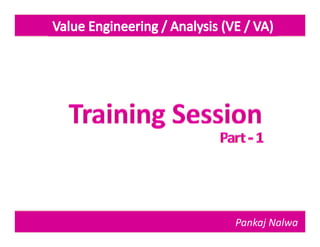
Value Engineering Part 1
- 1. Pankaj Nalwa
- 2. Profile of Trainer Industrial Experience of 16 years with well known organizations. Being from Engineering background and specialization in Tooling, done many projects of Product Development. MBA in International Business, helped in dealing with International clients according to norms and international law. Lead trainer for “A.P.Q.P”, “Value Engineering”, “P.P.A.P”, “F.M.E.A”, “Product Development Practices”, “Tool Room Management”, “Practices for Good Design”. Pankaj Nalwa
- 3. Perspective people processes View of Organization products results View of Customer outcomes benefits Pankaj Nalwa
- 4. Who are our Customers? Most Useful 1. End Users Least heard Example: Consumer, Service User 2. Intermediate Customers Example: Retailer, Distributor, OEM 3. Internal Customers Least Useful Example: Manufacturing, In-plant User Most heard Pankaj Nalwa
- 5. Capturing Voice of the Customer Pankaj Nalwa
- 6. Obtaining Voice of the Customer Who is the customer? What should we measure? How do we measure? How do we use what we measure? Pankaj Nalwa
- 7. What should we measure? Value mismatches Good performance and satisfactory perception Technical people Owner / User Faults & Complaints Similar completed projects Pankaj Nalwa
- 8. How do we measure? Any structured information gathering mechanism Focus group(s) of stake holders Telephonic interviews Mail questionnaires Personal interviews User logs Pankaj Nalwa
- 9. What is Value? Value is a measure of “Cost Effectiveness”. It is the relationship between functional need(s) and the cost to meet that need. Value = (Functional) Performance / (Unit) Cost Pankaj Nalwa
- 10. What is Good Value? Unnecessary performance even at very low cost is wasteful and thus is a poor Value. All functional performance costs money. But not all performance is needed or even wanted. Good Value is the lowest product cost required to achieve high customer / user acceptance. Pankaj Nalwa
- 11. Value Engineering Value Engineering is the formal or informal attempt to assure highest value by delivering all required functions at the lowest overall cost. It is a systematic review of a project, product or process to improve performance, quality and / or life-cycle cost by an independent muti-disciplinary team of specialists. Value Engineering is not a cost cutting process that reduces project life cycle time, scope or quality. Pankaj Nalwa
- 12. When is VE / VA study performed? About at the 25% of design stage Preliminary line and grade inspection Preferred alternate stage Pankaj Nalwa
- 13. Objectives of VE / VA Improve project quality Reduce project cost Foster innovation Eliminate unnecessary and costly design elements Ensure efficient investments Develop implementation procedures Pankaj Nalwa
- 14. Life Cycle Costing (LCC) Economic assessment of completing design alternatives Focuses on total costs Optimizes value and improves return on investment (ROI) for a given project Pankaj Nalwa
- 15. The Rule of Ten Pankaj Nalwa
- 16. Reasons for unnecessary project costs Lack of information Lack of innovation / ideas Temporary circumstances Honest wrong beliefs Changes in ownership requirements Lack of communication and specifications Outdated standards and specifications Pankaj Nalwa
- 17. Individual Efforts Process Project Designer Owner Engineers Users Manager Problem Team Effort Solution Pankaj Nalwa
- 18. Part – 2 includes Phases in VE / VA Process and Implementation. pankajnalwa@gmail.com Pankaj Nalwa
